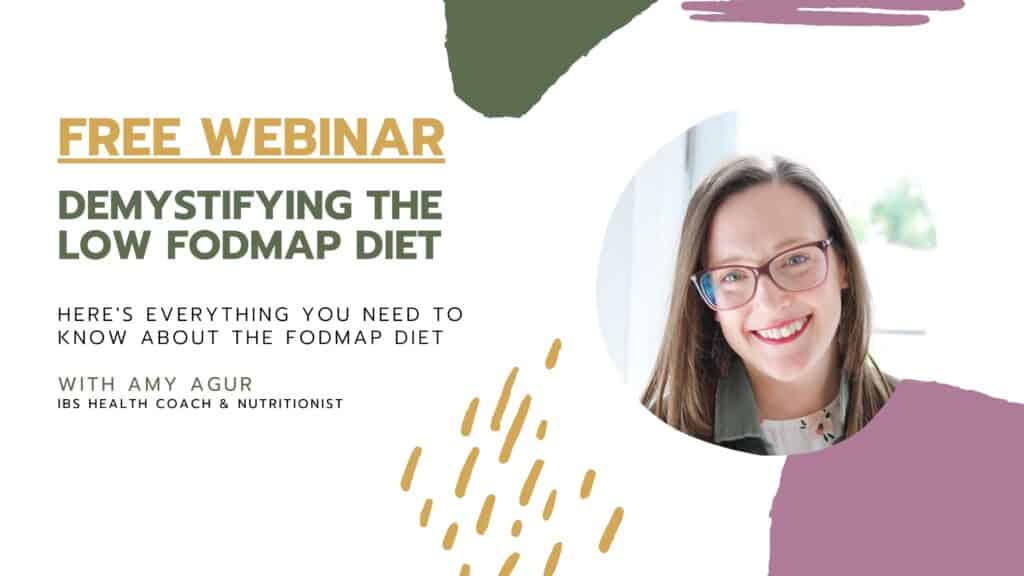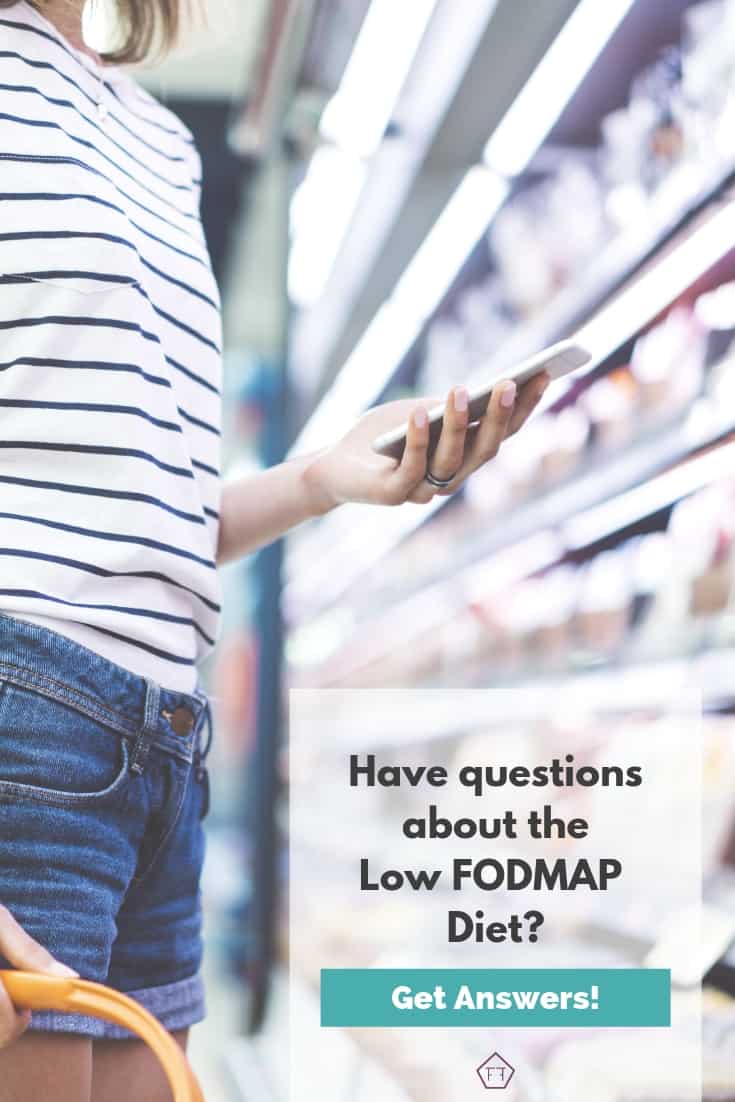Do you have questions about the Low FODMAP Diet? You’ve come to the right place, friend! This article is part four of my FAQ series, and today we’ll cover ten frequently asked questions about the Low FODMAP Diet. Let’s jump right in!
What is the Low FODMAP Diet?
The Low FODMAP Diet is a short-term program used to help people with IBS find common food triggers. The program consists of three stages: 1) elimination, 2) re-challenge, and 3) personalization. You can read a full overview of each stage here.
During the program, you will remove all high FODMAP foods from your diet for 2-6 weeks. Then each FODMAP group is tested individually to see if it triggers symptoms. Foods you tolerate well or that you can manage will be added back into the diet while foods that consistently trigger symptoms will be removed.
Research shows the low FODMAP program helps 3 out of 4 people with IBS reduce their symptoms by at least 50%.
When Should You Start the Low FODMAP Diet?
As the low FODMAP diet gains popularity, it’s being consistently recommended throughout the IBS community. While the program does help between 75-80% of patients manage their symptoms, it’s not necessarily the first thing you should try.
Before taking on a stressful and restrictive diet, you should consider testing common dietary triggers like caffeine, alcohol, spicy foods, greasy or high-fat foods, etc. and making sure you don’t have natural diuretics or laxatives lurking in your daily diet.
You should also consider incorporating lifestyle habits that promote healthy bowel movements like maintaining good sleep hygiene, moving your body, staying hydrated, making sure you’re pooping in the correct position, etc. You can find more IBS best practices here.If basic IBS best practices aren’t enough, you and your healthcare team may decide it’s time to try the Low FODMAP Diet.
Do You Need the Monash App?
The low FODMAP program was designed to keep as many foods in your diet as possible. So, Monash created the Monash app to put their research right in your pocket. Monash currently has the largest online database of high and low FODMAP foods. Plus, since they are the ones conducting the research used by most lists and apps, their information is always the most up to date and accurate.
Using tools like online lists, apps, or scanners can be problematic. Since you don’t know where they get their information, how accurate it is, or how often it’s updated, you’ll never know if you’re actually following a low FODMAP diet.
Also, many tools list foods as “safe” or “not safe” while the official program relies on serving sizes. Since many green foods have a cutoff point where they become high FODMAP, this information is crucial to your success.
Yes, the app is expensive, but it is the one you want! Plus, the money goes directly into future research, so you’re essentially donating to your own cause.
Can You Eat Too Many Low FODMAP Foods?
Many people have wondered if you can eat too many low FODMAP foods in one sitting. The answer is yes, it’s called FODMAP stacking. But, you don’t need to panic!
First, FODMAP stacking happens when you eat multiple servings from the same FODMAP group in one sitting. That means two servings of fructose will stack on one another while one serving of fructose and one serving of lactose will not.
Second, Monash has calculated their serving sizes so you can safely have more than one serving of most foods. To err on the side of caution, most FODMAP-trained dietitians recommend sticking to 1.5 servings of each FODMAP group per sitting.
The exception is fruits. Because fruits are already so high in FODMAPs, one serving of most fruits is close to the average person’s limit. So, most dietitians recommend sticking to one serving of fruit per sitting.
Does this sound complicated? Take a deep breath, friend! If you follow a balanced diet, you likely won’t end up with more than 1.5 servings on your plate anyway. So, while it’s important to be aware of FODMAP stacking, it’s not something you need to fret over in your day-to-day life.
Will the Low FODMAP Diet Heal Your Gut?
No, the Low FODMAP Diet does not help heal your gut. The low FODMAP program is a short-term diagnostic tool used to help people with IBS identify common food triggers. While identifying food triggers can increase our quality of life, it doesn’t address the underlying causes of IBS.
What If You’re Sensitive to All FODMAPs?
First of all, while some people are sensitive to most FODMAP groups, it’s highly unlikely you will react to every FODMAP.
If you’re having trouble reintroducing FODMAPs, first, make sure you’re testing in a clean environment. You should continue to follow a strict Low FODMAP Diet during the second phase of the program to make sure the only FODMAP in your body is the one you’re testing. You should also make sure your test food only contains one FODMAP and that you’re allowing for a “washout” period for your body to reset between each test.
If you’ve confirmed you’re testing the right foods in a clean environment, try picking a different food from the same FODMAP group. Like fibre, sugar, and fat, each food has a different amount of FODMAPs per serving. If you’re testing a food with a high amount of FODMAPs, you may have a stronger reaction than if you test food with a smaller amount. A FODMAP-trained dietitian can help you choose the right test foods for your body.
You can also try adjusting your serving sizes, eating the test food as part of a larger meal, or moving your test to a time of day your gut tends to be at it’s happiest.
If you’re completing the Low FODMAP Diet on your own, or if you’re working with a general dietitian, you should also consider consulting a FODMAP-trained dietitian. They may be able to suggest alternative ways to complete your tests and check your current test-method for user error.
Is the Low FODMAP Diet a Gluten Free Diet?
The short answer is, no. While FODMAPers are often encouraged to use gluten-free products, the Low FODMAP Diet is not a gluten-free diet.
For the record, FODMAPs are a specific group of short-chain carbohydrates while gluten is a protein. So, unless you have celiac disease, you’re limiting the FODMAP fructan in grains like wheat, rye, and barley, not the gluten itself.
Under the FODMAP umbrella, gluten-free products are a convenient way to narrow down the list of possible high-FODMAP ingredients. But, you don’t need to use all gluten-free products. Oats, for example, are often cross-contaminated with gluten. So, people with celiac disease opt for certified gluten-free oats. But, since we’re limiting fructan, not gluten, low FODMAP servings of any kind of oats are safe for you.
Remember, gluten-free products aren’t all low FODMAP. Make sure to check the label for other high FODMAP ingredients. For example, many gluten-free bakery items have high FODMAP ingredients like inulin/chicory root, amaranth flour, apple, pear, and mango juice or puree to make them taste better. Never assume because food is free of one FODMAP that it’s free of them all.

Are Meats, Fish, and Eggs Low FODMAP?
Yes! Because foods like beef, chicken, shrimp, etc. are made of protein they don’t contain any FODMAPs. So you can eat as much as you’d like without adding to your FODMAP load. Remember, if it can poop, it’s low FODMAP!
Is Sugar Low FODMAP?
Some people with IBS don’t absorb the molecule fructose correctly. If your intestines can’t absorb the fructose molecules, they’ll travel through the digestive system, pulling in water and being fermented by your gut bacteria.
However, when glucose and fructose travel through the intestine together, fructose molecules can hitch a ride out of the intestine with their glucose buddy. This means they’re absorbed properly and don’t cause a problem.
In the low FODMAP program, we’re trying limit fructose in excess of glucose. This means we try to manage the number of fructose molecules travelling through your digestive system alone.
Since sugars like table sugar, brown sugar, icing sugar, etc. are made of equal parts glucose and fructose (1 fructose + 1 glucose = 1 sucrose), these types of sugars are low FODMAP.
Is Fructose Malabsorption the Same as Fructose Intolerance?
When we say people with IBS are “sensitive” to fructose, what we mean is we suffer from “fructose malabsorption” – where fructose molecules aren’t absorbed properly.
Fructose Intolerance (also called Hereditary Fructose Intolerance), is a hereditary metabolic disease. In people with HFI, fructose is absorbed correctly by the intestines but, due to a mutation in a specific gene, the liver can’t produce the correct enzyme to break it down.
To manage their symptoms, people with HFI need to eliminate all sources of fructose from their diets (including low FODMAP sugars like table sugar, low FODMAP sweeteners, and fruits).
Heads up! Many people with HFI frequent the IBS community (as some low FODMAP recipes are suitable for people with HFI). If you see comments online saying something is unsafe for people with fructose intolerance, don’t panic! They’re not talking to you.
Final Thoughts
I hope you found the answers to these frequently asked questions helpful! If you have another question, shoot me an email at [email protected]. Tune in for the final post in my FAQ series to talk about some “should ask questions.”
You might also like one of these:
What is a FODMAP? Seriously, what the heck is a FODMAP? Check out this article for everything you need to know about what these sneaky little carbohydrates are and why they cause you trouble.
How to Complete the Re-Challenge Phase Ready to start the re-challenge phase? Here’s what you need to know about testing FODMAPs!
How to Survive the Holidays with IBS Worried about keeping your IBS symptoms under control this holiday season? Check out these practical tips on preventing and managing common IBS symptoms during stressful events.
If you like this post, don’t forget to share it! Together we’ll get the low FODMAP diet down to a science!

